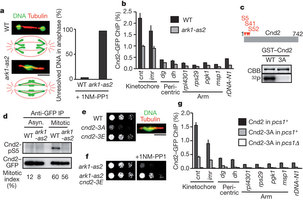摘要:在细胞分裂中,染色体的结构发生着动态的调整,这种变化在部分程度上依赖于凝集蛋白,凝集蛋白磷酸化促使其与组蛋白H2A和H2A.Z的结合,该项研究的结果阐明了有丝分裂过程中时空调节的分子基础。

凝集蛋白与组蛋白H2A结合形成细胞有丝分裂时的染色体结构
Chromosome structure is dynamically regulated during cell division, and this regulation is dependent, in part, on condensin. The localization of condensin at chromosome arms is crucial for chromosome partitioning during anaphase. Condensin is also enriched at kinetochores but its precise role and loading machinery remain unclear. Here we show that fission yeast (Schizosaccharomyces pombe) kinetochore proteins Pcs1 and Mde4—homologues of budding yeast (Saccharomyces cerevisiae) monopolin subunits and known to prevent merotelic kinetochore orientation—act as a condensin ‘recruiter’ at kinetochores, and that condensin itself may act to clamp microtubule binding sites during metaphase. In addition to the regional recruitment factors, overall condensin association with chromatin is governed by the chromosomal passenger kinase Aurora B. Aurora-B-dependent phosphorylation of condensin promotes its association with histone H2A and H2A.Z, which we identify as conserved chromatin ‘receptors’ of condensin. Condensin phosphorylation and its deposition onto chromosome arms reach a peak during anaphase, when Aurora B kinase relocates from centromeres to the spindle midzone, where the separating chromosome arms are positioned. Our results elucidate the molecular basis for the spatiotemporal regulation of mitotic chromosome architecture, which is crucial for chromosome partitioning.







